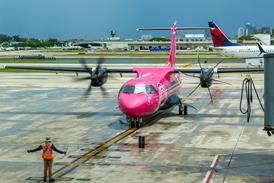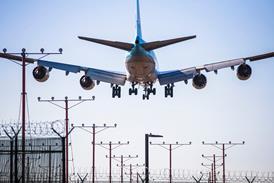Rotorcraft manufacturer Robinson plans to offer the company’s R66 light-single to the fill the US Army’s requirement for a new training helicopter.
Robinson unveiled its bid on 14 May at the Army Aviation Association of America conference in Nashville, Tennessee.
Although Robinson’s expertise lies in producing civil helicopters, chief executive David Smith says the company’s low-maintenance, affordable designs and vertically integrated manufacturing process make for a compelling offer.
“These aircraft are built with this concept of really, really light maintenance and extremely high uptime,” Smith says.
Robinson has some 10,500 aircraft currently in operation globally, according to Smith, with roughly 1,500 of those being R66s. The bulk of the remainder are R44s, which represents the most-produced civil helicopter in the world with some 8,000 examples delivered.

However, Smith thinks the R66 has the potential to surpass the popularity of the successful R44 – potentially with the help of the US Army.
The service currently operates the Airbus Helicopters UH-72A Lakota – a military version of the H145 light-twin civil type – as its primary rotary-wing trainer. Last October, the service unexpectedly released a request for information indicating it was exploring an alternative to the Lakota.
Airbus delivered the first UH-72A to the army in 2006. As of August, the company was supporting an army fleet of 223 Lakota trainers, along with 212 UH-72As and 18 UH-72Bs filling a utility role in the national guard.
The UH-72A has served as the army’s primary training helicopter since 2016.
Although still relatively young, army leaders say the Lakota has proven unsuitable for the trainer mission.
Speaking in Nashville on 14 May, the army’s senior aviation officer Major General Clair Gill said recent feedback from frontline rotary-wing units indicates that junior pilots are lacking fundamental airmanship skills.
“A lot of what I’m hearing is: they’re great system operators, but they don’t know how to fly the aircraft,” Gill says.
Part of the issue is apparently that the UH-72 is in fact too sophisticated for the needs of junior trainees.
“We took a very sophisticated aircraft that almost flies itself and used that to train basic pilot skills,” says army vice chief of staff General James Mingus.
For its next trainer, the army wants a bare bones light-single with minimal automation.
“We want [pilots] to be masters of their craft of being able to fly a helicopter in the old fashioned way, so that all that becomes instinctual.”

Robinson has made that concept central to its pitch, particularly a concept called “primacy of training”.
“What you learn first is what you revert back to when things don’t go right,” explains Will Fulton, Robinson’s vice-president of business development.
He argues the R66 represents an ideal platform for learning the fundamentals of rotary-wing flight, including power management, engine management, airspace awareness, navigation and communications, without extra frills that will distract students.
“It is simple, affordable, robust and fit for purpose,” he says.
The Nigerian air force currently operates the R66 as a trainer, while the Royal Jordanian Air Force uses the R44 in the same role. Several domestic law enforcement agencies in the USA also fly Robinson aircraft as an advanced trainer for military-style skills sets, such as night vision operations.
Robinson produces aircraft in the Los Angeles area, using a rare vertically integrated supply chain that extends all the way down to sheet metal cutting and shearing. The company says 85% of all R66 parts are fabricated in the Torrance, California manufacturing facility.
The company faces competition in the army trainer competition from Bell and Leonardo Helicopters. Lockheed Martin hopes to participate in the contracted services portion of the programme, which includes trainee instruction and aircraft sustainment.
Robinson has partnered aviation services provider M1 for the service portion of the contract, which is known as Flight School Next.































